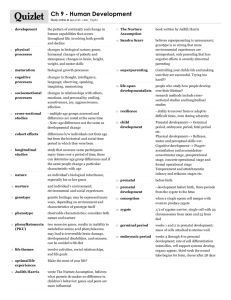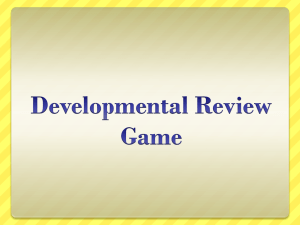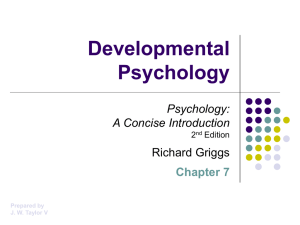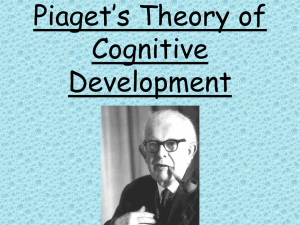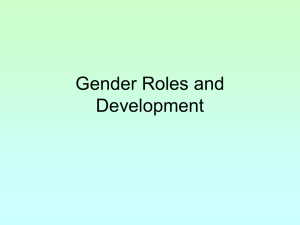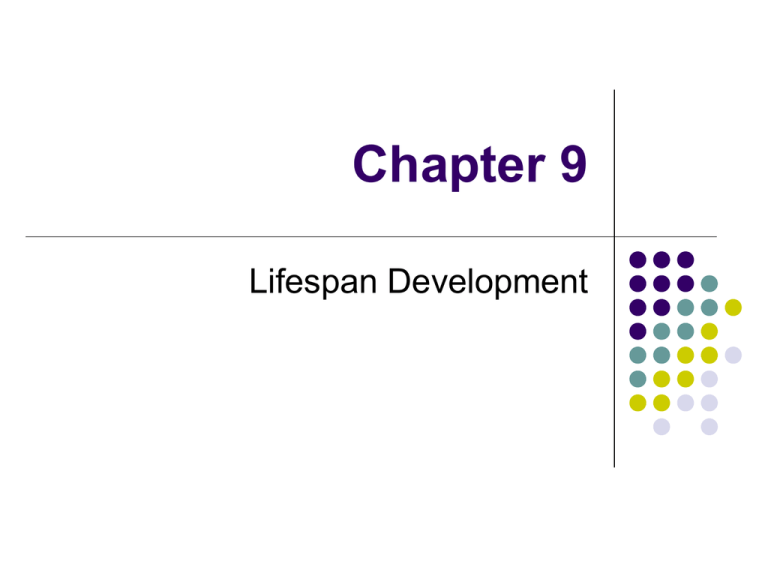
Chapter 9
Lifespan Development
Developmental Psychology
What shapes the way we change over time?
Focus on psychological changes across the
entire life span
Every area of psychology can be looked at
from this perspective
biological development
social development
cognitive/perceptual development
personality development
Fundamental Issues:
Nature vs. Nurture
What is role of heredity vs. environment in
determining psychological makeup?
Is IQ inherited or determined by early
environment?
Is there a ‘criminal’ gene?
Is sexual orientation a choice or genetically
determined?
These are some of our greatest societal
debates
Mistake to pose as ‘either/or’ questions
Fundamental Issues:
Is Development Continuous?
Development means change; change can be
abrupt or gradual.
Two views of human development
stage theories: there are distinct phases to
intellectual and personality development
continuity: development is continuous
Fundamental Issues in
Developmental Psychology
Critical period — Are there periods when an
individual is particularly sensitive to certain
environmental experiences?
Are the first hours after birth critical for parentchild bonding?
Is first year critical for developing trust?
Easier to learn a language before age 10?
Overview of Genetics
Humans have 23 pairs of chromosomes.
Chromosomes are long twisted strands
of DNA.
DNA is the chemical basis of heredity
and carries instructions.
Genes are the basic unit of heredity;
single unit of DNA on the chromosome
Dominant and Recessive
Genotype—underlying genetic makeup
Phenotype—traits that are expressed
Dominant genes—will always be expressed if
present
Recessive genes—will not be expressed
unless they are in a pair
Characteristic
Dominant
Recessive
Eye color
Brown
Grey, blue
Hair
Dark
Curly
Light
Straight
Hands
Extra fingers 5 fingers
Limb dwarfing Normal limbs
Face
Broad lips
Dimples
Thin lips
No dimples
Sex Linked Traits
Traits linked to the X or Y (sex)
chromosomes
Usually recessive and carried on the X
chromosome
Appear more frequently in one sex than
another
Color blindness, baldness, hemophilia,
Fragile X
Physical and Psychological
Development Related
Physical development begins at
conception
Physical maturity sets limits on
psychological ability
visual system not fully functional at birth
language system not functional until much later
Prenatal environment can have lifetime
influence on health and intellectual ability
Prenatal Development
Conception—when a sperm penetrates the
ovum
Zygote—a fertilized egg
Germinal period—first two weeks after
conception
Embryonic period—weeks three through
eight after conception
Fetal period—two months after conception
until birth
Prenatal Influences
on Development
Nutrition
Anxiety
Mother’s general health
Maternal age
Teratogens—any agent that causes
a birth defect (e.g., drugs, radiation,
viruses)
Infant Abilities
Infants are born with immature visual
system
Other senses function well on day 1
can detect movement and large objects
will orient to sounds
turn away from unpleasant odors
prefer sweet to sour tastes
Born with a number of reflex behaviors
Infant Reflexes
Rooting—turning the head and opening
the mouth in the direction of a touch on
the cheek
Sucking—sucking rhythmically in
response to oral stimulation
Babinski—fanning and curling toes
when foot is stroked
Infant Reflexes
Moro—throwing the arms out, arching
the back and bringing the arms together
as if to hold onto something (in
response to loud noise or sudden
change in position of the head)
Grasping—curling the fingers around
an object
Infant Attachment
Intense emotional bond between
infant and caregiver
Temperament
Easy—adaptable, positive mood, regular
habits
Slow to warm up—low activity, somewhat
slow to adapt, generally withdraw from
new situations
Difficult—intense emotions, irritable, cry
frequently
Average—unable to classify (1/3 of all
children)
Ainsworth’s
Strange Situation
Mother-child dyads were observed
in a playroom under four
conditions:
initial mother-child interaction
mother leaves infant alone in playroom
friendly stranger enters playroom
mother returns and greets child
Forms of Attachment
Securely attached—explores the room
when mother is present, becomes
upset and explores less when mother is
not present, shows pleasure when
mother returns
Avoidantly attached—a form of
insecure attachment in which child
avoids mother and acts coldly to her
Forms of Attachment
Anxious resistant attachment—a
form of insecure attachment where
the child remains close to mother
and remains distressed despite
her attempts to comfort
Universal Characteristics
of Human Language
Language development similar across
cultures; what are the common elements?
Morphemes—smallest meaningful units of
language
content morphemes (e.g., nouns, verbs, adjectives,
adverbs)
grammatical morphemes (e.g., articles, conjunctions,
some prefixes and suffixes)
Universal Characteristics
of Human Language
Phonemes—elementary vowel and
consonant sounds
Grammar—rules of language
phonology—how phonemes can be combined to
make morphemes
morphology—how morphemes can be combined
to make words
syntax—how words can be combined to make phrases
and sentences
Language Development
Infant preference for human speech over
other sounds
before 6 months can hear differences used in all
languages
after 6 months begin to hear only differences used in
native language
Cooing—vowel sounds produced 2–4
months
Babbling—consonant/vowel sounds between
4 to 6 months
Even deaf infants coo and babble
Language Development
MONTH
2
4
10
12
24
24+
Speech Characteristic
Cooing
vowel sounds
Babbling consonant/vowel
Babbling native language sounds
One-word stage
Two-word stage
Sentences
Piaget’s Theory of
Cognitive Development
Jean Piaget (1896–1980) Swiss psychologist
who became leading theorist in 1930’s
Piaget believed that “children are active
thinkers, constantly trying to construct more
advanced understandings of the world”
These “understandings” are in the form of
structures he called schemas
Piaget’s Approach
Primary method was to ask children to solve
problems and to question them about the
reasoning behind their solutions
Discovered that children think in radically
different ways than adults
Proposed that development occurs as a
series of ‘stages’ differing in how the world is
understood
Sensorimotor Stage (birth – 2)
Information is gained through the
senses and motor actions
In this stage child perceives and
manipulates but does not reason
Symbols become internalized through
language development
Object permanence is acquired
Object Permanence
The understanding that objects exist
independent of one’s actions or
perceptions of them
Before 6 months infants act as if
objects removed from sight cease to
exist
Can be surprised by
disappearance/reappearance of a face (peek-aboo)
Preoperational Stage
(2–7 years)
Emergence
of symbolic thought
Centration
Egocentrism
Lack
the concept of conservation
Animism
Artificialism
Conservation
Number
In conservation of number tests, two equivalent rows of coins
are placed side by side and the child says that there is the same
number in each row. Then one row is spread apart and the child
is again asked if there is the same number in each.
Conservation
Length
In conservation of length tests, two same-length sticks are
placed side by side and the child says that they are the same
length. Then one is moved and the child is again asked
if they are the same length.
Conservation
Substance
In conservation of substance tests, two identical amounts of clay
are rolled into similar-appearing balls and the child says that they
both have the same amount of clay. Then one ball is rolled out and
the child is again asked if they have the same amount.
Concrete Operational Stage
(7–12 years)
Understanding of mental operations
leading to increasingly logical thought
Classification and categorization
Less egocentric
Inability to reason abstractly or
hypothetically
Formal Operational Stage
(age 12 – adulthood)
Hypothetico-deductive
reasoning
Adolescent egocentrism
illustrated by the phenomenon of
personal fable and imaginary
audience
Critique of Piaget’s Theory
Underestimates children’s abilities
Overestimates age differences in
thinking
Vagueness about the process of
change
Underestimates the role of the social
environment
Lack of evidence for qualitatively
different stages
Information-Processing
Perspective
Focuses on the mind as a system,
analogous to a computer for analyzing
information from the environment
Developmental improvements reflect
increased capacity of working memory
faster speed of processing
new algorithms (methods)
more stored knowledge
What Are the Issues ?
Individuals develop socially
How do social relationships develop?
What factors drive social development?
biological
cultural
cognitive
Erikson’s Theory
Biological in belief that there are innate drives
to develop social relationships and that these
promote survival (Darwinism)
Divided life span into eight psychosocial
stages, each associated with a different drive
and a problem or crisis to resolve
Outcome of each stage varies along a
continuum from positive to negative
Stage 1 (Birth–1)
Trust vs. Mistrust
Infants
must rely on others for care
Consistent and dependable
caregiving and meeting infant
needs leads to a sense of trust
Infants who are not well cared for
will develop mistrust
Stage 2 (1–3 years)
Autonomy vs. Shame and Doubt
Children are discovering their own
independence.
Those given the opportunity to experience
independence will gain a sense of
autonomy.
Children that are overly restrained or
punished harshly will develop shame and
doubt.
Stage 3 (3–5 years)
Initiative vs. Guilt
Children are exposed to the wider
social world and given greater
responsibility.
Sense of accomplishment leads to
initiative whereas feelings of guilt can
emerge if the child is made to feel too
anxious or irresponsible.
Stage 4 (5–12 years)
Industry vs. Inferiority
Stage
of life surrounding mastery
of knowledge and intellectual skills
Sense of competence and
achievement leads to industry
Feeling incompetent and
unproductive leads to inferiority
Stage 5 (Adolescence)
Identity vs. Confusion
Developing a sense of who one is and
where one is going in life
Successful resolution leads to positive
identity
Unsuccessful resolution leads to
identity confusion or a negative identity
Stage 6 (Young adulthood)
Intimacy vs. Isolation
Time
for sharing oneself with
another person
Capacity to hold commitments
with others leads to intimacy
Failure to establish commitments
leads to feelings of isolation
Stage 7 (Middle adulthood)
Generativity vs. Stagnation
Caring
for others in family, friends,
and work leads to sense of
contribution to later generations
Stagnation comes from a sense of
boredom and meaninglessness
Stage 8
(Late adulthood to Death)
Integrity vs. Despair
Successful resolutions of all previous
crises leads to integrity and the ability
to see broad truths and advise those in
earlier stages
Despair arises from feelings of
helplessness and the bitter sense that
life has been incomplete
Some Definitions
Sex—the biological category of male or female;
sexual intercourse
Gender—cultural, social, and psychological
meanings associated with masculinity or femininity
Gender roles—behaviors, attitudes, and personality
traits designated either masculine or feminine in a
given culture
Gender identity—a person’s psychological sense of
being male or female
Sexual orientation—direction of a person's
emotional and erotic attractions
Gender Role Stereotypes
The beliefs and expectations people hold about
the typical characteristics, preferences, and
behaviors of men and women
In the US, men and women view the female
stereotype more positively than the male
stereotype. This is called benevolent sexism
There is a high degree of agreement on the
characteristics associated with each sex among
people of many different cultures.
Gender Related Differences
Differences do not mean deficiencies
Three main areas of gender differences
Personality
Cognitive abilities
Sexual attitudes and behaviors
Personality Differences
No significant differences between men
and women on most characteristics
Women tend to be more nurturant than
men
Men tend to be more assertive than
women
Cognitive Differences
No differences for most cognitive abilities
Verbal, reading, and writing—females
consistently score higher
Spatial skills—males outscore females on
mentally rotating objects, females score
better on remembering locations of objects
Math Skills—males score slightly better
than females
Gender Role Development
Between ages 2-3 years, children can identify
themselves and other children as boys or girls.
The concept of gender or sex, however, is based
more on outward characteristics such as clothing.
Toddler girls tend to play more with dolls and ask
for help more than boys.
Toddler boys tend to play more with trucks and
wagons and tend to play more actively.
After age 3 years, we see consistent gender
differences in preferred toys and activities.
Sexual Development
Puberty—stage where an individual reaches
sexual maturity and is physically capable of
sexual reproduction
Primary sex characteristics—sex organs directly
involved in reproduction
Secondary sex characteristics—develop during
puberty, not directly involved in reproduction, but
distinguish male from female
Adolescent growth spurt—period of accelerated
growth during puberty
Menarche—female’s first menstrual period
Social Learning Theory
Gender roles are acquired through the basic
processes of learning, including reinforcement,
punishment, and modeling.
Gender Schema Theory
Gender-role development is influenced by the
formation of schemas, or mental representations,
of masculinity and femininity.
An example of how a child forms a schema associated with
gender. A girl is offered a choice of 4 toys to play with.
Not
Boys
for me Avoid/
Toy car
Approach
object
Doll
Who
Is it relevant
for?
to me?
Forget
I am a girl
Orange
Artichoke
Girls
Assign to
category and
For me remember/
Approach
Kohlberg’s Theory of
Moral Development
Assessed moral reasoning by posing
hypothetical moral dilemmas and
examining the reasoning behind
people’s answers
Proposed six stages, each taking into
account a broader portion of the social
world
Levels of Moral Reasoning
Preconventional—moral reasoning is
based on external rewards and
punishments
Conventional—laws and rules are
upheld simply because they are laws
and rules
Postconventional—reasoning based on
personal moral standards
Stage 1: Obedience and
Punishment Orientation
A
focus on direct consequences
Negative actions will result in
punishments
Positive actions will result in
rewards
Stage 2: Mutual Benefit
Reflects the understanding that
different people have different selfinterests, which sometimes come in
conflict
Getting what one wants often requires
giving something up in return
Stage 3: Interpersonal
Expectations
An attempt to live up to the
expectations of important others
Positive actions will improve relations
with significant others
Negative actions will harm those
relationships
Stage 4: Law-and-Order
Morality
To maintain social order, people
must resist personal pressures
and follow the laws of the larger
society.
Stage 5: Legal Principles
A balance is struck between respect for
laws and ethical principles that
transcend specific laws.
Laws that fail to promote general
welfare or that violate ethical principles
can be changed, reinterpreted, or
abandoned.
Stage 6: Universal Moral
Principles
Self-chosen ethical principles
Profound respect for sanctity of human life
Moral principles take precedence over laws
that might conflict with them, such as
conscientious objectors.
Adult Development
Genetics and lifestyle combine to determine
course of physical changes.
Social development involves marriage and
transition to parenthood.
Paths of adult social development are varied
and include diversity of lifestyles.
Late Adulthood
Old age as a time of poor health, inactivity,
and decline is a myth.
Activity theory of aging—life satisfaction is
highest when people maintain level of activity
they had in earlier years
Death and Dying
In general, anxiety about dying tends to
decrease in late adulthood.
Kubler-Ross stages of dying
Denial
Anger
Bargain
Depression
Acceptance
Not universally demonstrated



